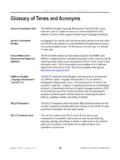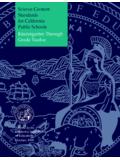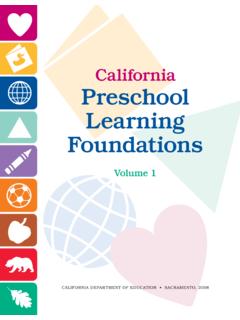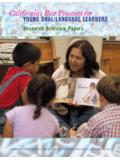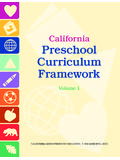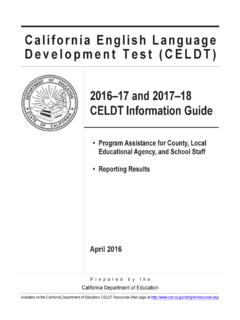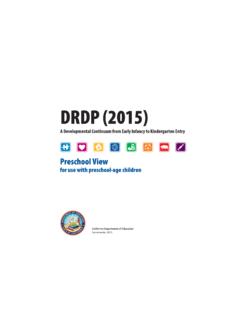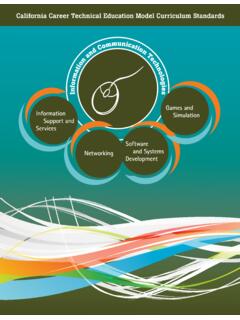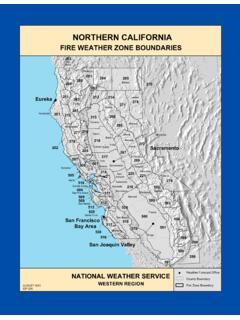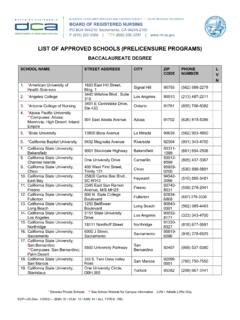Transcription of California Preschool Curriculum Framework
1 ISBN 978-0-8011-1733-6 Print bar code hereCaliforniaPreschool Curriculum FrameworkVolume 3 California DEPARTMENT OF EDUCATION SACRAMENTO, 2013 California Preschool Curriculum Framework Volume 3 ISBN 978-0-8011-1733-63 CaliforniaPreschool CurriculumFrameworkVolume 3 History Social Science SciencePublishing InformationThe California Preschool Curriculum Framework , Volume 3, was developed by the Child Development Division, California Depart-ment of Education (CDE). This publication was edited by Faye Ong and John McLean, working in cooperation with Laura Bridges, Child Development Consultant. It was designed and prepared for printing by the staff of CDE Press, with the cover designed by Juan D. Sanchez. The document was published by the Department of Education, 1430 N Street, Sacramento, CA 95814-5901. It was distributed under the provisions of the Library Distribution Act and Government Code Section 11096. 2013 by the California Department of EducationAll rights reservedISBN: 978-0-8011-1733-6 Reproduction of this document for resale, in whole or in part, is not InformationCopies of this publication are available for purchase from the Cali-fornia Department of Education.
2 For prices and ordering informa-tion, please visit the Department Web site at or call the CDE Press sales office at guidance in the California Preschool Curriculum Framework , Volume 3, is not binding on local educational agencies or other en-tities. Except for the statutes, regulations, and court decisions that are referenced herein, the document is exemplary, and compliance with it is not mandatory. (See Education Code Section )ContentsA Message from the State Superintendent of Public Instruction ..vAcknowledgments ..viiCHAPTER 1 Introduction to the Framework ..1 California s Preschool Children ..3 Overarching Principles ..5 Organization of the Framework ..9 English-Language Development and Learning in All Domains ..11 Universal Design for Learning ..14 Curriculum Planning ..15 The Daily Schedule ..24 The Curriculum -Planning Process ..29 Endnotes ..38 Bibliography ..40 CHAPTER 2 History Social Science ..43 Guiding Principles ..45 Environments and Materials.
3 46 Summary of the History Social Science Foundations ..49 Summary of the Strands and Substrands ..50 Self and Society ..51 Culture and Diversity ..53 Relationships ..60 Social Roles and Occupations ..63 Bringing It All Together ..66 Engaging Families ..67 Questions for Reflection ..68 Becoming a Preschool Community Member (Civics) ..69 Skills for Democratic Participation ..70 Responsible Conduct ..75 Fairness and Respect for Other People ..78 Conflict Resolution ..80 Bringing It All Together ..83 Engaging Families ..84 Questions for Reflection ..85 Sense of Time (History) ..86 Understanding Past Events ..88 Anticipating and Planning Future Events ..91 Personal History ..94 Historical Changes in People and the World ..97 Bringing It All Together ..100 Engaging Families ..101 Questions for Reflection ..102 Sense of Place (Geography and Ecology) ..103 Navigating Familiar Locations ..105 Caring for the Natural World.
4 108 Understanding the Physical World Through Drawings and Maps ..112 Bringing It All Together ..115 Engaging Families ..115 Questions for Reflection ..116 Marketplace (Economics) ..117 Exchange ..118 Bringing It All Together ..121 Engaging Families ..121 Questions for Reflection ..122 Concluding Thoughts ..123 Map of the Foundations ..124 Teacher Resources ..125 Endnotes ..126 Bibliography ..130 CHAPTER 3 Science ..135 Guiding Principles ..138 Environments and Materials ..142 Summary of the Science Foundations ..151 Summary of the Strands and Substrands ..152 Scientific Inquiry ..153 Observation and Investigation ..154 Documentation and Communication ..166 Bringing It All Together ..172 Engaging Families ..173 Questions for Reflection ..175iiiPhysical Sciences ..176 Properties and Characteristics of Nonliving Objects and Materials ..178 Changes in Nonliving Objects and Materials ..186 Bringing It All Together ..193 Engaging Families.
5 194 Questions for Reflection ..195 Life Sciences ..196 Properties and Characteristics of Living Things ..198 Changes in Living Things ..206 Bringing It All Together ..212 Engaging Families ..213 Questions for Reflection ..214 Earth Sciences ..215 Properties and Characteristics of Earth Materials and Objects ..216 Changes in the Earth ..221 Bringing It All Together ..227 Engaging Families ..227 Questions for Reflection ..229 Concluding Thoughts ..230 Map of the Foundations ..231 Teacher Resources ..232 Appendix: Suggested Materials ..234 Endnotes ..237 Bibliography ..241 Glossary ..244ivA Message from the State Superintendent of Public InstructionI am pleased to present the California Pre- school Curriculum Framework , Volume 3, a publication I believe will be a major step in working to close the school-readiness gap for young children in our state. Cre-ated as a companion to the California Preschool Learning Foundations, Volume 3, this Framework presents strategies and information for educators to enrich learn-ing and development opportunities for all of California s Preschool the third volume of the Preschool learning foundations, this third volume of the Curriculum Framework focuses on two learning domains: history social science and science.
6 It includes guiding principles; the vital role of the family in early learning and development; the diver-sity of young children in California ; and the ongoing cycle of observing, document-ing, assessing, planning, and implement-ing Curriculum . The Preschool Curriculum Framework takes an integrated approach to early learning and describes how curricu-lum planning considers the connections between different domains as children engage in teacher-guided learning activi-ties. Chapters 2 and 3 focus on the learning domains. Each chapter provides an over-view of a domain, the foundations for that domain, principles in planning Curriculum , and Curriculum strategies illustrated by vignettes. The strategies pertain to both the learning environment and teachers interactions with children. These chap-ters offer key principles and a rich variety of ideas for early childhood educators to support the learning and development of Preschool children. Additionally, there are specific principles and strategies for teach-ing children who are English themes are interwoven through-out this volume: early childhood educators need to be intentional in supporting learn-ing in all domains, young children learn through play, and young children s fami-lies are their first teachers.
7 Young chil-dren benefit greatly from comprehensive and integrated Curriculum planning that includes history social science and sci-ence. As young children play, they express themselves by exploring ideas about the past, where they live, fairness and respect for others, their families cultural tradi-tions, and how to use money to purchase things. They also are naturally interested in scientific inquiry, the properties and characteristics of nonliving objects and materials, living things, and the earth and materials. Observation of young children s play gives insights into how to build on their interests and expand their learning. Early educators also enrich young chil-dren s learning through ongoing collabora-tion with families. Together, early educa-tors and family members can create mean-ingful learning experiences for children in Preschool and at Preschool Curriculum Framework speaks to new early childhood educators as well as experienced ones. It recognizes the best practices already used by pre-school programs and provides new ideas that bring the Preschool learning founda-tions to life for everyone responsible for the care and education of young children.
8 Vol-ume 3 completes the Preschool Curriculum Framework and should prove to be instru-mental in preparing children for TORLAKSONS tate Superintendent of Public InstructionvviiAcknowledgmentsT he development of the Preschool Curriculum Framework involved many people. The following groups contributed: project leaders; principal writers; community college faculty advisers; advisers on English-language development and cultural diversity; universal design advisers; additional consultants and reviewers; project staff and advisers from the WestEd Center for Child and Family Studies; staff from the California Department of Education; early childhood education stakeholder organizations; participants in the formative and review focus groups; and participants in the Web-posting LeadersThe following staff members are gratefully acknowledged for their contributions: Peter Mangione and Katie Monahan, Writers Special thanks are extended to the principal writers for their expertise and 1: Introduction to the FrameworkPeter Mangione, WestEdMary Jane Maguire-Fong, American River CollegeMarie Jones, American River CollegeChapter 2: History Social ScienceJanet Thompson, University of California , DavisRoss Thompson, University of California , DavisKelly Twibell, University of California , DavisChapter 3: ScienceOsnat Zur, WestEdCommunity College Faculty Advisers Special thanks are extended to the faculty advisers for their expertise and contributions:Caroline Carney, Monterey Peninsula College Amy Obegi, Solano Community CollegeAdvisers on English-Language Development and Cultural Diversity Particular thanks are extended to the following advisers for their involvement in the project.
9 Gisela Jia, City University of New York, Lehman CollegeAntonia Lopez, National Council of La RazaAlison Wishard Guerra, University of California , San DiegoUniversal Design AdvisersThe following universal design experts are gratefully acknowledged for their contributions:Maurine Ballard-Rosa, California State University, SacramentoLinda Brault, WestEdAdditional Consultants and ReviewersParticular thanks are also extended to the following consultants for their involvement in the project:Gay Macdonald, University of California , Los Angeles, Early Care and EducationSusan Wood, California Institute of Technology (Caltech), Children s CenterviiiWestEd Center for Child and Family Studies Project Staff and AdvisersLinda BraultMelinda BrookshireCaroline Pietrangelo Owens Teresa RagsdaleAmy Schustz-AlvarezCharlotte TilsonAnn-Marie Wiese California Department of EducationThanks are extended to the following staff members: Richard Zeiger, Chief Deputy Superintendent of Public Instruction; Lupita Cortez Alcal , Deputy Superintendent, Instruction and Learning Support Branch; Camille Maben, Director, Child Development Division; Cecelia Fisher-Dahms, Administrator, Quality Improvement Office, Child Development Division; Desiree Soto, Administrator, Northern Field Services, Child Development Division; and Laura Bridges, Consultant, Child Development Division, for ongoing revisions and recommendations.
10 During the lengthy development process, many CDE staff members were involved at various levels. Additional thanks are extended to Deborah Sigman, Deputy Superintendent, District, School, and Innovation Branch; Gavin Payne, former Chief Deputy Superintendent; Gail Brodie, Sy Dang Nguyen, Luis Rios, Mary Smithberger, and Charles Vail, Child Development Division; and Meredith Cathcart, Special Education following individuals are also acknowledged for their contributions to the vignettes:Aleksandra Klitinek, Prekindergarten Teacher, New York City Department of EducationGloria de Napoli Peropat, LCSW-R, Prekindergarten Social Worker/Early Childhood Specialist, New York City Department of EducationEarly Childhood Education Stakeholder OrganizationsRepresentatives from many statewide organizations provided input that affected various aspects of this Curriculum Alliance for ChildrenAlliance for a Better CommunityAsian Pacific Islander Community Action Network (APIsCAN)Association of California School AdministratorsBaccalaureate Pathways in Early Childhood & Education (BPECE)Black Child Development Institute (BCDI), Sacramento AffiliateCalifornia Alliance of African American Educators (CAAAE) California Association for Bilingual Education (CABE) California Association for the Education of Young Children (CAEYC) California Association for Family Child Care (CAFCC) California Association of Latino Superintendents and Administrators (CALSA)

